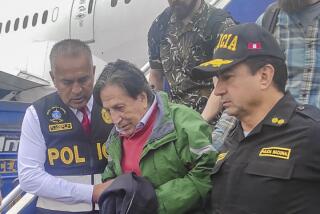Body of Marcos Back Home in Philippines
- Share via
LAOAG, Philippines — Nearly four years after his death in exile, the body of President Ferdinand E. Marcos was returned today to the Philippines and a lavish welcome by thousands of supporters.
As the chartered Continental Airlines jet touched down, women in the crowd wept. A horn was sounded in a wailing tone as part of a ritual announcing death.
Marcos was overthrown 7 1/2 years ago in a people’s uprising. He died Sept. 28, 1989, in Honolulu of a heart attack. Corazon Aquino, who succeeded Marcos as president, had refused to allow the body to be returned for burial; it had been stored in Hawaii in an air-conditioned crypt.
The crowd, jubilant at President Fidel V. Ramos’ decision to allow the body to be returned, pushed and shouted as the 727 jet, which bore an image of Marcos and the words “I am a Filipino” on the fuselage, taxied to the terminal.
Many in the crowd made a “V for Victory” sign, the symbol of the Marcos administration, which had been tarnished by allegations of corruption and tyranny.
Although Ramos lifted Aquino’s ban on the repatriation of Marcos’ body, he has continued to object to giving the former dictator a state funeral or burying him in Manila, as the Marcos family desires. Nor has he acceded to Imelda Marcos’ pleas that he at least attend her husband’s funeral, scheduled for Friday in his hometown of Batac.
The widow told reporters that she plans to keep Marcos’ remains on display in the mausoleum until the government yields to her demand for a burial in the National Heroes’ Cemetery in Manila.
After having lain in a refrigerated, glass-topped coffin inside an air-conditioned crypt in Hawaii for the last four years, the deteriorating corpse is to be kept in a sealed casket for a series of rituals and ceremonies here before eventually being installed in a specially built mausoleum in Batac.
There, according to his family and his mortician, the remains of the late president are to be put on public display in a glass coffin that resembles a large aquarium.
Marcos’ body was returned to Laoag, the capital of Ilocos Norte, his home province in the Philippines.
After arriving aboard a special flight from Guam, Marcos’ black-lacquered, gold-handled casket was placed on a platform at the airport amid singing, dancing and a variety of rites. Among them was a ritual wailing and a ceremony called banga, in which Ilocanos break black earthen pots to drive away evil spirits.
Marcos supporters say it is no accident that his corpse arrived Sept. 7. Seven was always considered the lucky number of the notoriously superstitious Marcos, and now it is being observed even in death.
The casket then is scheduled to be carried on a horse-drawn caisson with military honors to St. William Cathedral here for a Mass, then moved to a specially built stage in front of the governor’s office, to be displayed overnight.
On Monday, thousands of people packed a cathedral in Agana, Guam, on Monday to honor Marcos as the body was brought to the U.S. territory on its way to the Philippines.
“Despite the many things they say, he is my father, he is my president, he is my friend, he is my God,” said Marcos’ son, Ferdinand Jr., at a Mass inside the Dulce Nombre de Maria Cathedral.
More to Read
Sign up for Essential California
The most important California stories and recommendations in your inbox every morning.
You may occasionally receive promotional content from the Los Angeles Times.












